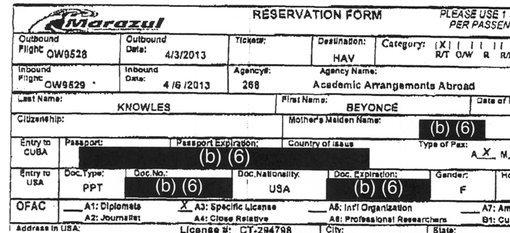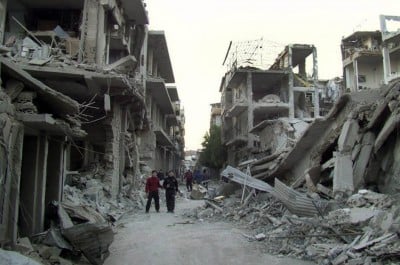NBC News’ report, “
‘The great tragedy of this century’: More than 2 million refugees forced out of Syria,” stated:
More than 2 million Syrians have poured into neighboring countries as refugees, the United Nations revealed on Tuesday.
Around 5,000 people per day are fleeing the three-year conflict, which the U.N. says has already claimed over 100,000 lives.
“Syria has become the
great tragedy of this century — a disgraceful humanitarian calamity
with suffering and displacement unparalleled in recent history,” said
António Guterres, the U.N.’s high commissioner responsible for
refugees.
But, while the UN and nations across the West feign shock over the
growing humanitarian catastrophe unfolding in and around Syria, the goal
of a violent sectarian conflict and its predictable, catastrophic
results along with calls to literally “bleed” Syria have been the
underlying strategy of special interests in the United States, Israel,
Saudi Arabia and their regional partners since at least 2007.
A Timeline: How the Syrian Conflict Really Unfolded
Western media networks have ensured that a singular narrative of
“pro-democracy” uprisings turning violent in the face of brutal
oppression by the Syrian government after the so-called “Arab Spring” is
disseminated across the public. In reality, “pro-democracy” protesters
served as a tenuous smokescreen behind which armed foreign-backed
extremists took to the streets and countrysides of Syria to execute a
sectarian bloodbath years in the making. Here is a timeline that
illuminates the true cause of Syria’s current conflict and the foreign
interests, not the Syrian government, responsible for the tens of
thousands dead and millions displaced during the conflict.
1991: Paul Wolfowitz, then Undersecretary of
Defense, tells US Army General Wesley Clark that the US has 5-10 years
to “clean up those old Soviet client regimes, Syria, Iran, Iraq, before
the next great superpower comes on to challenge us.”
Fora.TV: Wesley Clark at the Commonwealth Club of California, October 3, 2007.
2001: A classified plot is revealed to US Army
General Wesley Clark that the US plans to attack and destroy the
governments of 7 nations: Iraq, Syria, Lebanon, Libya Somalia, Sudan,
and Iran.
Fora.TV: Wesley Clark at the Commonwealth Club of California, October 3, 2007.
2002: US Under Secretary of State John Bolton
declares Syria a member of the “Axis of Evil” and warned that “the US
would take action.”
BBC: “US Expands ‘Axis of Evil’” May 6, 2002.
2005: US State Department’s National Endowment for
Democracy organizes and implements the “Cedar Revolution” in Lebanon
directly aimed at undermining Syrian-Iranian influence in Lebanon in
favor of Western-backed proxies, most notably Saad Hariri’s political
faction.
Counterpunch: “Faking the Case Against Syria,” by Trish Schuh November 19-20, 2005.
Image: Via Color Revolutions and Geopolitics:
“As illustrated by the images above, Lebanon’s so-called [2005] Cedar
Revolution was an expensive, highly-professional production.” (click
image to enlarge)
….
2005: Ziad Abdel Nour,
an associate of Bush Administration advisers, policy makers, and media
including Neo-Conservatives Paula Dobriansky, James Woolsey, Frank
Gaffney, Daniel Pipes, Joseph Farah (World Net Daily), Clifford May, and
Daniel Nassif of US State Department-funded Al Hurra and Radio Sawa,
admits: “
Both
the Syrian and Lebanese regimes will be changed- whether they like it
or not- whether it’s going to be a military coup or something else… and
we are working on it. We know already exactly who’s going to be the replacements. We’re working on it with the Bush administration.”
Counterpunch: “Faking the Case Against Syria,” by Trish Schuh November 19-20, 2005.
2006: Israel
attempts, and fails, to destroy Hezbollah in Lebanon after a prolonged aerial bombard that resulted in thousands of civilian deaths.
CNN: “UN: Hezbollah and Israel agree on Monday cease-fire,” August 13, 2006.
2007: Seymour Hersh in the New Yorker
reveals that US, Israel, Saudi Arabia and Hariri in Lebanon as well as
the Syrian arm of the Muslim Brotherhood were assembling, arming,
training, and heavily funding a sectarian extremists front, many of whom
had direct ties to Al Qaeda, to unleash in both Lebanon and Syria.
The
goal was to create and exploit a sectarian divide between Sunni and
Shi’ia Muslims. Hersh interviewed intelligence officers who expressed
concerns over the “cataclysmic conflict” that would result, and the need
to protect ethnic minorities from sectarian atrocities. The
report indicated that extremists would be logistically staged in
northern Lebanon where they would be able to cross back and forth into
Syria.
New Yorker: “The Redirection,” by Seymour Hersh, March 5, 2007.
2008:
The US State Department begins training, funding, networking, and
equipping “activists” through its “Alliance for Youth Movements” where
the future protest leaders of the “Arab Spring,”
including Egypt’s “April 6 Movement” were brought to New York, London, and Mexico,
before being trained by US-funded CANVAS in Serbia, and then returning home to begin preparations for 2011.
Land Destroyer: “2011 – Year of the Dupe,” December 24, 2011.
 2009
2009: The Brookings Institution published a report titled, “
Which Path to Persia?” (.pdf),
which admits that the Bush Administration “evicted” Syria from Lebanon
without building up a strong Lebanese government to replace it (p. 34),
that Israel struck a “nascent” Syrian nuclear program, and states the
importance of neutralizing Syrian influence before any attack on Iran
can be carried out (p. 109). The report then goes on to describe in
detail the use of listed terrorist organizations against the government
of Iran,
in particular the Mujahedin-e Khalq (MEK) (p. 126) and
Baluch insurgents in Pakistan (p.132).
Brookings Institution: “Which Path to Persia? Options for a New American Strategy Toward Iran,” June 2009.
2009-2010:
In an April 2011 AFP report,
Michael Posner, the assistant US Secretary of State for Human Rights
and Labor, admitted that the “US government has budgeted $50 million in
the last two years to develop new technologies to help activists protect
themselves from arrest and prosecution by authoritarian governments.”
The
report went on to admit that the US (emphasis added) “organized
training sessions for 5,000 activists in different parts of the world. A session held in the Middle East about six weeks ago gathered activists from Tunisia, Egypt, Syria and Lebanon
who returned to their countries with the aim of training their
colleagues there.” Posner would add, “They went back and there’s a
ripple effect.”
AFP: “US Trains Activists to Evade Security Forces,” April 8, 2011.
2011: Posner’s US trained, funded, and equipped
activists return to their respective countries across the Arab World to
begin their “ripple effect.”
Protests, vandalism , and arson sweep across Syria and “
rooftop snipers” begin attacking both protesters and Syrian security forces,
just as Western-backed movements were documented doing in Bangkok, Thailand one year earlier. With a similar gambit already unfolding in Libya,
US senators begin threatening Syria with long planned and sought after military intervention.
Land Destroyer: “Syria: Intervention Inevitable,” April 29, 2011.
Image:
Real genocidal atrocities during the “Arab Spring” occurred at the
hands of NATO and its proxy sectarian terrorists. Pictured is Sirte,
Libya, after NATO-armed rebels surrounded it, cut off power, water, food, and emergency aid, and allowed NATO to bombard it
with daily airstrikes before a final orgy of death and destruction left
its streets and facades crumbling. This is the “civilian protection”
the UN and its enforcement arm NATO plan on bringing to Syria.
….
2012: With NATO’s Libyan intervention resulting in a weak
US-backed Tripoli client-regime, perpetual infighting, nationwide genocide, and
the succession of Benghazi in the east, the
NATO-backed Libyan Islamic Fighting Group (LIFG), listed by the
US State Department as a Foreign Terrorist Organization (listed #27) begins mobilizing weapons, cash, and fighters to begin destabilizing Syria.
Headed by LIFG’s Abdul Hakim Belhaj, this would be the first confirmed presence of Al Qaeda in Syria, flush with NATO weapons and cash.
The Washington Post would confirm, just as stated by Hersh in 2007, that
the
US and Saudi Arabia were arming the sectarian extremists, now labeled
the “Free Syrian Army.” The Post also admits that the Syrian Muslim
Brotherhood, as stated in Hersh’s 2007 report, was also involved in
arming and backing extremist fighters. Land Destroyer: “US Officially Arming Extremists in Syria,” May 16, 2012.
 Image: Brookings Institution’s Middle East Memo #21 “Assessing Options for Regime Change (.pdf),” makes no secret that the humanitarian “responsibility to protect” is but a pretext for long-planned regime change.
Image: Brookings Institution’s Middle East Memo #21 “Assessing Options for Regime Change (.pdf),” makes no secret that the humanitarian “responsibility to protect” is but a pretext for long-planned regime change.
….
2012: The US policy think-tank Brookings Institution in its Middle East Memo #21
“Assessing Options for Regime Change (.pdf),”
admits that it does not seek any negotiated ceasefire under the UN’s
“Kofi Annan peace plan” that leaves Syrian President Bashar al-Assad in
power and would rather arm militants, even with the knowledge they will
never succeed,
to “bleed” the government, “keeping a regional adversary weak, while avoiding the costs of direct intervention.”
This reveals that US policy does not view US interference in Syria as a
moral imperative predicated on defending human rights, but rather using
this false predication to couch aspirations of regional hegemony.
Land Destroyer: “US Brookings Wants to “Bleed” Syria to Death,” May 28, 2012.
And, just this year, it was revealed that despite the West’s feigned
military and political paralysis regarding the Syrian conflict, the US
and Great Britain have been covertly funding and arming sectarian
extremists to the tune of billions of dollars
and arming them with literally thousands of tons of weaponry.
Despite claims of “carefully vetting” “moderate” militant factions, the
prominence of Al Qaeda-linked extremist groups indicates that the
majority of Western support, laundered through Qatar and Saudi Arabia,
is being purposefully put into the hands of the very sectarian
extremists identified in Seymour Hersh’s 2007 article, “The
Redirection.”
US Created and is Now Using Syrian Catastrophe to Justify Intervention
The non-debate taking place now to justify US military intervention
in a conflict they themselves started and have intentionally
perpetuated, is whether chemical weapons were used in Damascus on August
21, 2013 – not even “who” deployed them. The weakness of the US’
argument has seen an unprecedented backlash across both the world’s
populations and the global diplomatic community. And
despite only 9% of the American public supporting a military intervention in Syria, Congress appears poised to not only green-light “limited strikes,” but may approve of a wider military escalation.
In Seymour Hersh’s 2007 New Yorker article, “
The Redirection,”
Robert Baer, a former CIA agent in Lebanon, warned of the sectarian
bloodbath the US, Israel, and Saudi Arabia were planning to unleash. He
stated:
“we’ve
got Sunni Arabs preparing for cataclysmic conflict, and we will need
somebody to protect the Christians in Lebanon. It used to be the French
and the United States who would do it, and now it’s going to be
Nasrallah and the Shiites”
Hezbollah’s leader, Hassan
Nasrallah, also featured in Hersh’s report, would in turn also warn of
an imminent and spreading sectarian war purposefully stoked by the West:
Nasrallah
said he believed that President Bush’s goal was “the drawing of a new
map for the region. They want the partition of Iraq. Iraq is not on the
edge of a civil war—there is a civil war. There is ethnic and
sectarian cleansing. The daily killing and displacement which is taking
place in Iraq aims at achieving three Iraqi parts, which will be
sectarian and ethnically pure as a prelude to the partition of Iraq.
Within one or two years at the most, there will be total Sunni areas,
total Shiite areas, and total Kurdish areas. Even in Baghdad, there is a
fear that it might be divided into two areas, one Sunni and one
Shiite.”
He went on, “I can say that President Bush is lying when he says he
does not want Iraq to be partitioned. All the facts occurring now on the
ground make you swear he is dragging Iraq to partition. And a day will
come when he will say, ‘I cannot do anything, since the Iraqis want the
partition of their country and I honor the wishes of the people of
Iraq.’ ”
Nasrallah said he believed that America also wanted to bring about
the partition of Lebanon and of Syria. In Syria, he said, the result
would be to push the country “into chaos and internal battles like in
Iraq.” In Lebanon, “There will be a Sunni state, an Alawi state, a
Christian state, and a Druze state.” But, he said, “I do not know if
there will be a Shiite state.”
It would be difficult for anyone to look across the scarred landscape
of today’s Syria and not see that this horrific conspiracy was realized
in full. The Western media
is now acquainting the public
with the possibility of a partitioned Syria, echoing the warnings of
Nasrallah years ago. The goals of a US military strike would be to
“degrade” the capabilities of the Syrian government, while bolstering
the terrorist legions still operating within and along Syria’s borders.
What we are witnessing in Syria today is the direct result of a
documented conspiracy, not by a “brutal Syrian regime” “oppressing” its
own people, but of a US, Israel, and Saudi Arabia radicalizing, arming,
and unleashing a sectarian tidal wave they knew well ahead of time would
cause atrocities, genocide, mass displacements and even the
geopolitical partitioning of Syria and beyond. The intentional
destabilization of the region is meant to weaken Lebanon, Syria, Iran,
and Iraq – and even Saudi Arabia, Qatar, Jordan, and others – to
accomplish what the depleted, impotent US and Israeli forces could not
achieve. Military intervention now seeks to tip the balance of an
already teetering region.
The attacks on Syria are not humanitarian by any measure. They are
simply the latest stage of a long-running plan to divide and destroy the
region, leaving the West the sole regional hegemonic power.














